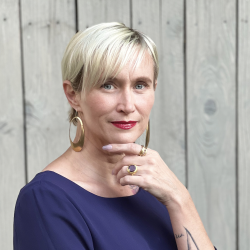
What We've Been Told
“Can’t we just have a nice meal?” my mother asked at the Thanksgiving dinner table after my first college class in Native American history, where for the first time I was viscerally woken up to some of the horrors perpetrated against the Native peoples of this continent—the smallpox epidemic, the land grab orchestrated through the Dawes Allotment Act, the use of Manifest Destiny to justify all manner of cruelty. To put the meal in historical context, I had read aloud a gruesome primary source about grave robbing by some of the same colonists present at the 1621 gathering of Pilgrims and Wampanoag men. I also declared my intent to switch my major to Native American Studies (and move across the country to do so).
Because of this personal awakening, I have great empathy for teachers who strive to unpack their learned false narratives, not only the origins of the Thanksgiving holiday, but much of the pre-contact and first-contact Americas on the docket of standards this time of year. As a non-Indigenous person who has focused the majority of my career in Indigenous spaces, I look to November as an opportunity to face history in a way that is honest, critical, and timely. This Native American Heritage Month (each November), I invite you to use PBL as the natural avenue to further your own understanding and Indigenize your teaching.
Challenging What We've Been Told
John Larmer, former editor in chief of PBLWorks, wrote the blog “Black History Projects & Moving Beyond History Months” wherein he acknowledges the ongoing debate about the need for ethnic history months. He concludes that multi-racial teaching and learning should happen throughout the school year, but the month-long spotlight can crank up the wattage.
This work of addressing historical misconceptions is crucial. I think of the Native American students across the country in predominantly non-Native schools. For generations they have been subjected to lessons about the first Thanksgiving that reduce their ancestors to feathered caricatures, fail to look at the event with a wider lens, or lack acknowledgement of the lived experiences of contemporary Native peoples. Some of these same students came to me as tenth graders, full of pain and mistrust, because they had been lied to and expected more of the same in my classroom. Additionally, every November, Native educators are retraumatized when burdened with educating their colleagues on the origin of Native North American genocide. No student or teacher should have their history so cruelly warped or ignored.
For many Native Americans, Thanksgiving is a day of mourning. Even the simple act of acknowledging this leads students to think more critically, examine more deeply, and be empowered to create a more complete portrayal of past and current events. As teachers, we want to “get it right” and feel betrayed by the single story we may have been told and then repeated. Moving to a more precise, contextualized understanding of what a project centering Indigenous Americans can be requires work—both inner work and a reexamination of the content we teach. The reward is a decolonization of Native history and culture in the classroom. Students reap the benefit of a more truthful understanding of the 574 Native nations that share the area called the United States.
To illuminate Indigenous voices in your teaching, learn from and with, instead of just about.
The Transformation Within
How does a teacher go about this inner work and reexamination of history? The beauty (and sometimes frustration) of growing our understanding of what it means to be a culturally responsive, historically exacting teacher is that the journey is not a linear one, nor does it have a destination. You’ll make mistakes, get distracted, be uncomfortable. The power is in the process.
If you are thinking about this historical reckoning for the first time, before feeding your American history lessons to the paper shredder, devote even a few hours to examine where you are on your racial equity journey. You might start with a look at a free professional development course like Project READY, funded by the Institute of Museum and Library Services and created by universities and public school systems. Project READY: Reimagining Equity and Access for Diverse Youth is a series of self-paced modules focused on “improving relationships with, services to, and resources for youth of color and Native youth.”
If you have progressed on your equity path and culturally responsive teaching practice but are not versed in Native North American history, educate yourself on the narratives that counter the dominant stories told about the history of Indigenous peoples and Indigenous-colonizer relations. Fellow National Faculty Maribel Gonzalez recommends the book Unsettling Settler-Colonial Education: The Transformational Indigenous Praxis Model, which introduces a framework to decolonize and Indigenize your practice. Additionally, the University of Saskatchewan has free professional development, Indigenous Voices: Online Learning Modules. Each module is about three hours long and addresses topics such as Power and Privilege, Land Agreements, and Indigenous Education. Although some of the content is specific to Canada’s First Nations, it can build awareness of Native histories across the continent. After you’ve completed the modules, head to your local library and grab a copy of Anton Treuer’s (Ojibwe) book, Everything You Wanted to Know About Indians but Were Afraid to Ask. There is a young readers edition as well.
If you simply want to immerse yourself in new content in service of Indigenizing your teaching, read sources like Cultural Survival Quarterly and Indian Country Today news. Watch a webinar from the National Indian Education Association (NIEA). I highly recommend the webinar on Authentic Ways of Representing American Indian Culture in PreK-12 School Curriculum. Binge a Native-produced show like Reservation Dogs or documentary like Lakota Nation vs. United States. One of my go-to podcasts when I’m cooking dinner or walking the dog is Teaching Hard History from Learning for Justice.
Once you have furthered your own understanding, it is time to get your students exploring Native American history from various angles, investigating deeper issues, and answering complex questions.
Since investigation and complexity is at the heart of sustaining inquiry throughout a project, use the resources below as a starting point for constructing a Gold Standard project in which students grapple with, ask profound questions, and reach new learning.
- Native Knowledge 360 Degrees from the Smithsonian National Museum of the American Indian is a rich and expertly researched set of educational materials and professional development services for teaching Native culture and history. Guided by a set of essential understandings, these lessons go beyond the cursory glance at the past to break down stereotypes and aid students in thinking critically about everything from the foods they eat to the political structures they’ll inherit. There is even a lesson on rethinking Thanksgiving celebrations.
- In the weeks leading up to the Thanksgiving holiday, lean into the opportunity to examine this history more critically with help from the National Education Association’s NEA Resources for Teaching Thanksgiving, with insight from Dr. Star Yellowfish, Director of Native American Student Services for Oklahoma City Public Schools (OKCPS). You’ll find book recommendations and lesson plans for every grade level.
- Facing History and Ourselves “helps educators prepare students to participate in civic life—using intellect, empathy, ethics, and choice to stand up to bigotry and hate in their own lives, communities, and schools” (Facing History and Ourselves, About page). I’ve used their resources as the foundation for many projects in my high school history classroom. Their compilation of 20 Teacher Resources on Native American History and Culture is an excellent launch for accurate project ideation.
- Another organization with a large bank of resources (124 by my count) for teaching “the people’s history” of Native America is the Zinn Education Project, born out of the work of scholar and author Howard Zinn.
As you’re connecting your new learning to project planning, the more you can localize the learning—both historical and contemporary, across the disciplines—the better. States like Hawaii and Alaska (Alaska has had the Alaska Cultural Standards since 1998) have inaugurated a movement to localize and indigenize, with other states, districts and schools launching their own initiatives. What these innovators can teach us is that localizing our teaching to center the voices of First Peoples benefits us all—by enriching our communities, broadening our perspectives, and giving us vetted tools for managing future challenges.
Perhaps the most tangible and comprehensive example of Indigenizing learning can be found in Hawaii, where the Hawaii Department of Education’s Nā Hopena A‘o (HĀ) framework of outcomes ushers educators to infuse the six core values and beliefs (belonging, responsibility, excellence, aloha, total well-being, Hawai’i) into every school’s curriculum and culture. Every student has a chance to understand their role and responsibility to each other and to their environment through āina (land)-based education. The HĀ framework is unique to Hawaii and that’s a good thing.
Likewise, the more we can think local and be tribe-specific, the better. For example, when I teach about the Wampanoag nation’s first contact with Europeans, I juxtapose that with talking about, and hearing from, the Puyallup, Nisqually and Muckleshoot nations in my region that enjoyed and nurtured the bounty of the Puget Sound at what is now the busy port of Tacoma, Washington, just a few miles from where students sit in their classroom. It was said that “when the tides were out, the table was set,” because the area was so rich in natural resources. These Twulshootseed-speaking bands travel by canoe to celebrate and give away their bounty in ceremonies called potlatches—a true ThanksGIVING!
Seeing the Impact on our Students
Erica Licht and Khalil Gibran Muhammad, Ph.D., writing about historical truth-telling in civics education, said, “An honest education centers these histories and makes them integral to the core concepts of learning. At best, this education becomes a foundational component of critical thinking—not only teaching the histories but also asking students to consider and understand ideas such as: What does this mean for me and for my friends? What is my responsibility for ensuring I do no harm, consider the well-being of others and promote equity and democratic values?” (A Call for Anti-Bias Education by Erica Licht and Khalil Gibran Muhammad, Ph.D., Learning for Justice, Issue 5, Fall, 2023).
To take a driving question like the ones above, make meaning of it, use it to further understand others and themselves, and then translate the question into action, is the engine of any project. Through that process, students get to try on roles that they would otherwise, with a more traditional or singular approach to teaching content, be unexposed to. The perspectives you allow into the classroom can help students envision themselves as:
- Indigenous culture bearers*
- Climate innovators Activists for missing and murdered Indigenous women
- Indigenous filmmakers*
- Allies for their Two-Spirit LGBTQ+ friends
- Story amplifiers of boarding school survivors
- Promoters of the repatriation/land back movement
What they produce as they take on these roles can go much further than our established learning targets, alchemizing what’s possible in the classroom and beyond.
Examining and challenging what we’ve been told, taking our own journey of discovery, and applying that to project design and implementation is a superb way to honor Native American History Month. And honoring the complexities of contemporary Native peoples in all their dimensionality and fullness will have an impact on your entire practice and your students.
*Specific to Indigenous students.

